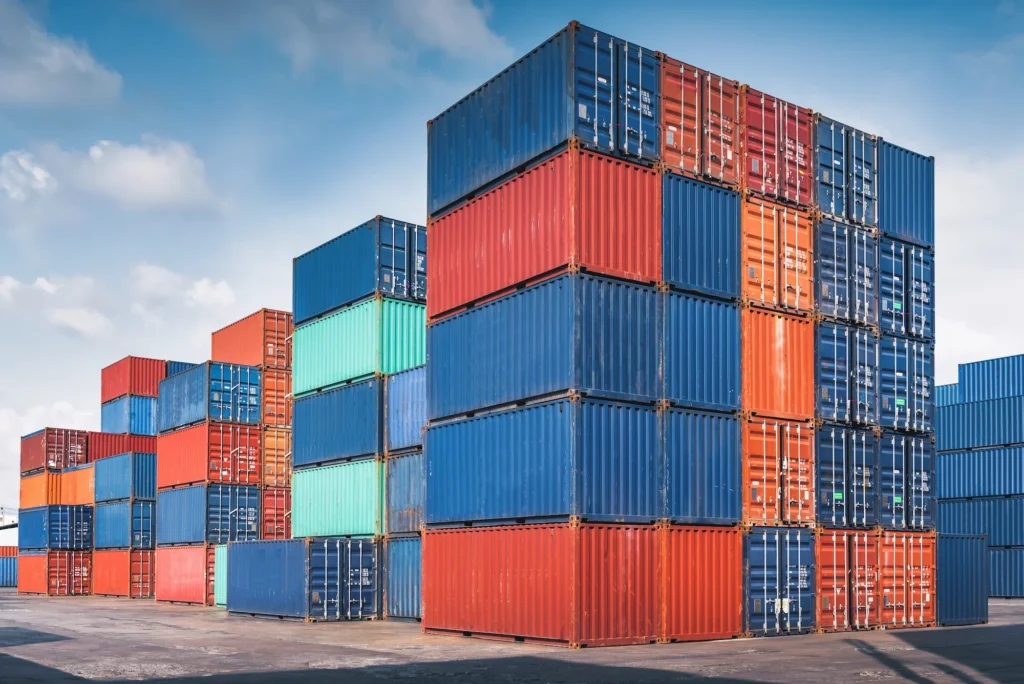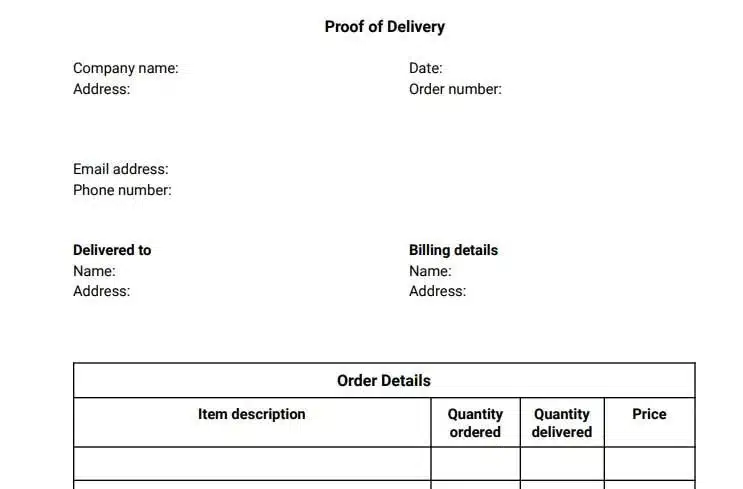Containers are essential for shipping goods internationally. There are many different types and sizes of containers. They depend on the type of goods and how they will be shipped. Did you know that around 90% of the world’s goods are transported by ship? Many containers have been created to handle this large amount of shipping. Each type has its unique purpose. This article will examine the different types and sizes of containers used to transport goods worldwide. We will explain their characteristics and uses in detail to help you understand the different logistics needs of international trade.

Container size
Standard Container Sizes (SCS)
Standard containers usually come in two main sizes:
20-foot Standard Container
- External dimensions: L 6.06 m × W 2.44 m × H 2.59 m
- Internal dimensions: L 5.90 m × W 2.35 m × H 2.39 m
- Volume: about 33m3
- Maximum load: about 22,000 kg
Suitable for most standard cargo transportation.
40-foot standard container
- External dimensions: L 12.19 m × W 2.44 m × H 2.59 m
- Internal dimensions: L 12.03 m × W 2.35 m × H 2.39 m
- Volume: about 67m3
- Maximum load: about 26,000 kg
Ideal for long-distance transportation of large cargoes.
45ft and 40ft High Cube Containers
40ft High Cube Container
- External dimensions: L 12.19 m × W 2.44 m × H 2.89 m
- Internal dimensions: L 12.03 m × W 2.35 m × H 2.69 m
- Volume: about 76m3
It is ideal for cargo requiring more vertical space, such as bulk or long items.
45ft High Cube Container
- External Dimensions: L 13.72 m × W 2.44 m × H 2.89 m
- Internal Dimensions: L 13.56 m × W 2.35 m × H 2.69 m
- Volume: about 86m3
Suitable for transportation of bulky cargoes, especially those with height requirements.
Open Top Containers Sizes
Open Top Containers differ from standard containers in that the top can be opened for cargo that needs to be loaded and unloaded from the top, such as over-height cargo or cargo that cannot be loaded or unloaded through the door.
20ft Open Top Container
- External Dimensions: L 6.06 m × W 2.44 m × H 2.59 m
- Interior Dimensions: L 5.90 m × W 2.35 m × H 2.39 m
- Volume: about 33m3
40ft Open Top Container
- External Dimensions: L 12.19 m × W 2.44 m × H 2.59 m
- Interior dimensions: L 12.03 m × W 2.35 m × H 2.39 m
- Volume: about 67m3
Reefer container Size
Reefer Containers are containers with refrigeration devices for temperature-sensitive cargoes, such as foodstuffs and medicines. Reefer containers are available in the following standard sizes:
20-foot Reefer Container
- External Dimensions: L 6.06 m × W 2.44 m × H 2.59 m
- Internal Dimensions: L 5.90 m × W 2.35 m × H 2.39 m
- Volume: about 28m3
- Maximum load: about 22,000 kg
Suitable for more minor reefer needs.
40-foot Reefer Container
- External dimensions: L 12.19 m × W 2.44 m × H 2.59 m
- Internal dimensions: L 12.03 m × W 2.35 m × H 2.39 m
- Volume: about 56m3
- Maximum load: about 26,000 kg
Suitable for transportation of large quantities of refrigerated cargo.
Container Type
Standard Container
The Standard Container is the most common type used to transport most goods. It is sturdy, waterproof, and dustproof and suitable for transporting various types of dry cargo.
- Characteristics: Without ventilation, it is suitable for dry cargo that does not need special protection.
- Size: including 20-foot and 40-foot standard container.
High Cube Container
High Cube Containers are taller than standard containers, providing more vertical space, and are suitable for transporting taller cargo or items that require more storage space.
- Characteristics: Height with more volume is 30cm higher than standard containers.
- Size: Commonly, there are 40-foot-high cube containers and 45-foot-high cube containers.
Open Top Container
An open-top container is suitable for loading and unloading cargo from the top as it can be opened. It is usually used for transporting goods with irregular height or requiring special loading and unloading.
- Characteristics: The top can be opened to facilitate the loading and unloading super-high cargo or cargo that cannot be loaded and unloaded through standard doorways.
- Size: Usually available in 20-foot and 40-foot open-top containers.
Reefer Container
Reefer Containers are equipped with temperature control equipment and transport goods with strict temperature requirements, such as food and medicine.
- Features: With refrigeration and temperature control equipment, the temperature can be set according to the demand.
- Size: There are 20 feet and 40 feet reefer containers.
Flat Rack Container
The Flat Rack Container has no enclosure, only the bottom plane and support. It is suitable for transporting significant, overweight, or ultra-high cargo, such as machinery, steel, and construction materials.
- Characteristics: It is suitable for transporting bulk and specially shaped cargo without an enclosure or top.
- Size: Usually 20 feet and 40 feet size.
Tank Container
A Tank Container is a container used for transportation of liquid goods, especially chemicals, food liquids, oils, etc.
- Characteristics: Its shape is similar to a large tank, usually made of stainless steel, which is corrosion—and pressure-resistant.
- Size: 20-foot and 40-foot tank containers are common.
Ventilated Container
Ventilated containers have specialized ventilation holes and are used for transporting goods that require good air circulation, such as certain agricultural products (dried fruits, coffee beans, etc.).
- Features: Ventilation holes on the container help to keep the cargo well-ventilated and prevent mold or rotting.
- Size: Commonly, there are 20 feet and 40 feet ventilated containers.
Insulated Container
Insulated containers are used to transport temperature-sensitive goods that do not require refrigeration. They are insulated to help maintain the cargo’s temperature.
- Features: The outer walls of the container are insulated, making it suitable for some goods that need to be kept at room temperature.
- Size: Common sizes are 20 feet and 40 feet.
How do you choose the correct container for your cargo?
Choosing the correct container requires comprehensive consideration based on the characteristics of the cargo, transportation needs, and the specifics of the destination. Here are a few key factors that can help you make a reasonable choice:
1. Cargo type
Dry cargo: If it is ordinary dry cargo, such as electronic products, textiles, small hardware, etc., a dry cargo container is the first choice. Its fully enclosed structure protects the goods from external environmental factors. For example, when loading computer motherboards and other electronic components, dry containers can prevent dust and moisture from damaging them.
Refrigerated cargo: Refrigerated containers are a necessary choice for perishable goods such as meat, fruits, vegetables, and dairy products. It is important to pick according to the range of refrigerated temperature required for the cargo. For example, 0 – 4°C is suitable for the transportation of most leafy vegetables, while around—18°C is suitable for the transportation of frozen meat.
Large or ultra-high cargo: For oversized cargo such as construction machinery, large industrial equipment, etc., open-top containers or frame containers are more suitable. Open-top containers are convenient for loading and unloading large cargoes from the top, such as some higher-height machinery and equipment, which are conveniently loaded and unloaded by cranes. The frame container mainly transports ultra-long, ultra-wide, ultra-high, large-scale equipment, such as wind turbine blades. Its unique frame structure allows the cargo to be loaded and fixed in the surroundings.
Liquid cargo: Oil, chemical raw materials, beverages, and other liquid goods need to be transported in tank containers. The tanks are sealed to ensure that the liquid cargo will not leak during transportation, and the tank material can be selected according to the liquid’s characteristics (such as corrosivity, volatility, etc.).
2. Cargo dimensions
- Length, width, and height: Measure the maximum length, width, and height of the cargo. If the cargo size is smaller than the internal size of a standard container (20 foot, 40 foot, etc.) and there is no special requirement (such as ultra-high, ultra-wide, etc.), the general standard container can meet the demand.
- Irregularly shaped cargo: For irregularly shaped cargo, it is necessary to consider its placement in the container and space utilization. To better fix the goods, it may be necessary to choose an open-top container or a frame container.
3. Cargo weight
- Container Weight Limits: Know the maximum weight limits for different types and sizes of containers. For example, a standard 20-foot container has a maximum capacity of about 24 tons, and a standard 40-foot container has a maximum capacity of about 26 tons. Ensure that the weight of the cargo does not exceed the weight limit of the selected container, as this may result in transportation safety issues or additional transportation costs (e.g., overweight penalties).
- Cargo density: It is also essential to consider the density of the cargo. If the cargo is denser and heavier but relatively minor, choose a container with sufficient load capacity. Conversely, if the cargo density is small and large in volume but lightweight, you can choose a larger container volume to use the container space fully. For example, transporting metal ores and other high-density goods focuses on the container’s capacity. In contrast, transporting foam and other low-density goods pays more attention to the container’s volume.
4. Transportation requirements
- Transportation distances and routes: In the case of long-distance transportation, especially routes involving different climatic zones or complex road conditions, it may be necessary to consider the container’s durability and the degree of protection of the goods. For goods transported by sea, due to the complexity of the maritime environment, it is necessary to ensure that the container is well-sealed and waterproof. If the transportation route passes through mountainous areas or areas with poor road conditions, choose containers with sturdy structures to reduce the risk of damage to the goods during transportation.
- Loading and unloading conditions: consider the convenience of cargo loading and unloading. If the loading and unloading locations have large cranes and other equipment, open-top containers or containers with convenient loading and unloading facilities may be more appropriate. If the loading and unloading facilities are limited, choosing standard containers and loading and unloading them through conventional equipment such as forklifts may be necessary. For example, in some small terminals without large lifting equipment, it is more convenient to use 20-foot standard containers to load and unload cargo via forklift.
5. Cost factors
- Cost of leasing or purchasing containers: The decision to lease or purchase containers is based on the frequency of goods transportation and long-term needs. If goods are only transported occasionally, renting a container may be more affordable; if goods are transported for a long period of time and in large quantities, buying a container may be a better choice. Different types and sizes of containers have different prices for leasing or purchasing. Generally speaking, the price of a 45-foot container will be higher than that of a 20-foot container.
- Transportation Costs: Different types of containers may affect transportation costs. For example, oversized or overweight containers may incur additional transportation costs. Also, refrigerated containers will cost more to ship than regular dry containers because they require refrigeration equipment to run, which consumes energy.
You may be interested in the following content:
- 40-Foot Container Dimensions, Weights and Uses
- What is a cfs(container freight station)? International shipping guide
- What You Need to Know About Container Transportation Costs
- Choosing the correct container: 20-foot container vs 40-foot container
- 20-Foot Container Dimensions, Weights and Uses
- China to US Container Transportation Guide
- SOC vs. COC Containers: Choosing the Right Fit for Your Freight
- International Container Transport, 2025 Comprehensive Guide




